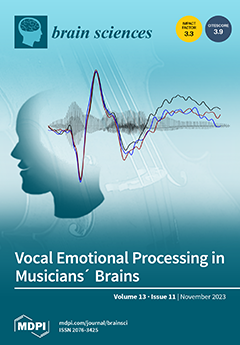Objective: To compare the EEG changes in vegetative state (VS) patients and non-craniotomy, non-vegetative state (NVS) patients during general anesthesia with low-dose propofol and to find whether it affects the arousal rate of VS patients. Methods: Seven vegetative state patients (VS group: five
[...] Read more.
Objective: To compare the EEG changes in vegetative state (VS) patients and non-craniotomy, non-vegetative state (NVS) patients during general anesthesia with low-dose propofol and to find whether it affects the arousal rate of VS patients. Methods: Seven vegetative state patients (VS group: five with traumatic brain injury, two with ischemic–hypoxic VS) and five non-craniotomy, non-vegetative state patients (NVS group) treated in the Department of Neurosurgery, Peking University International Hospital from January to May 2022 were selected. All patients were induced with 0.5 mg/kg propofol, and the Bispectral Index (BIS) changes within 5 min after administration were observed. Raw EEG signals and perioperative EEG signals were collected and analyzed using EEGLAB in the MATLAB software environment, time–frequency spectrums were calculated, and EEG changes were analyzed using power spectrums. Results: There was no significant difference in the general data before surgery between the two groups (
p > 0.05); the BIS reduction in the VS group was significantly greater than that in the NVS group at 1 min, 2 min, 3 min, 4 min, and 5 min after 0.5 mg/kg propofol induction (
p < 0.05). Time–frequency spectrum analysis showed the following: prominent α band energy around 10 Hz and decreased high-frequency energy in the NVS group, decreased high-frequency energy and main energy concentrated below 10 Hz in traumatic brain injury VS patients, higher energy in the 10–20 Hz band in ischemic–hypoxic VS patients. The power spectrum showed that the brain electrical energy of the NVS group was weakened R5 min after anesthesia induction compared with 5 min before induction, mainly concentrated in the small wave peak after 10 Hz, i.e., the α band peak; the energy of traumatic brain injury VS patients was weakened after anesthesia induction, but no α band peak appeared; and in ischemic–hypoxic VS patients, there was no significant change in low-frequency energy after anesthesia induction, high-frequency energy was significantly weakened, and a clear α band peak appeared slightly after 10 Hz. Three months after the operation, follow-up visits were made to the VS group patients who had undergone SCS surgery. One patient with traumatic brain injury VS was diagnosed with MCS-, one patient with ischemic–hypoxic VS had increased their CRS-R score by 1 point, and the remaining five patients had no change in their CRS scores. Conclusions: Low doses of propofol cause great differences in the EEG of different types of VS patients, which may be the unique response of damaged nerve cell residual function to propofol, and these weak responses may also be the basis of brain recovery
Full article






